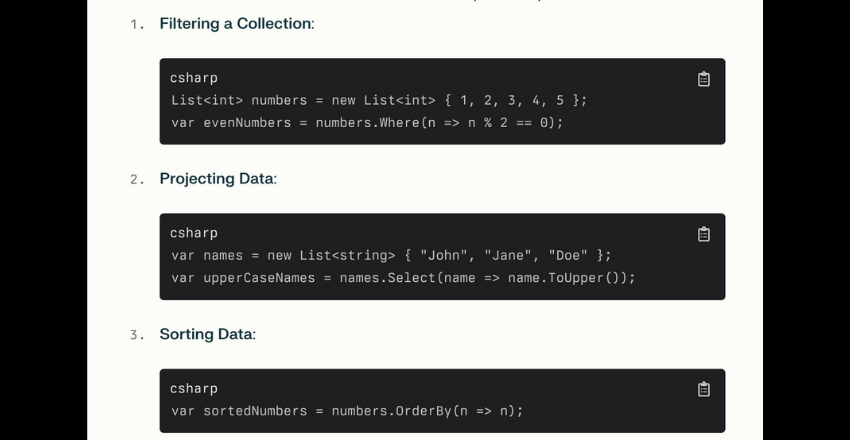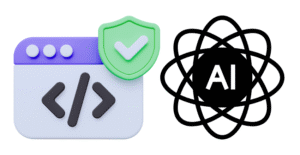This LINQ for Beginners offers a gateway to efficient data handling, introducing fundamental concepts through clear, practical examples. to kickstart your journey with LINQ in C#? It’s time to break away from the overwhelming tutorials and get hands-on. Let’s clear the air and simplify things.
Many beginners get lost in theoretical explanations, missing out on the true potential of LINQ’s simplicity and power.
Ready to dive in headfirst? Embrace a practical, project-based approach to mastering LINQ that will set you up for success as a beginner.
Language Integrated Query (LINQ) is a powerful programming model introduced with .NET Framework 3.5 and C# 3.0, designed to simplify data querying and manipulation.
It allows developers to write queries directly within C# (or VB.NET), offering a unified approach to query various data sources, such as in-memory collections, databases, XML documents, and more.
This guide aims to provide beginners with an easy understanding of LINQ, its syntax, and its applications.

Introduction to LINQ
LINQ stands for Language Integrated Query, a set of technologies integrated into the .NET Framework to provide a consistent query experience across different data sources. It extends the capabilities of the C# and Visual Basic languages, allowing you to query data using familiar syntax.
LINQ queries can work with any data source that implements the IEnumerable<T> interface, making it versatile for various applications.
Why Use LINQ?
The primary advantage of LINQ is its ability to offer a uniform querying interface across different data sources. Before LINQ, developers had to learn different query languages and APIs for different types of data (e.g., SQL for databases, XPath for XML).
LINQ simplifies this by providing a single, integrated querying language. It also enhances code readability and maintainability by allowing queries to be written directly in C# or VB.NET.
Key Concepts and Syntax
LINQ introduces several key concepts and syntaxes that are essential for beginners to understand:
Query Syntax and Method Syntax: LINQ queries can be expressed in two ways: query syntax and method syntax. Query syntax is similar to SQL and is more readable for those familiar with SQL. Method syntax uses extension methods and lambda expressions, offering more flexibility and functionality[4][8].
Standard Query Operators: LINQ provides a set of standard query operators, such as Where, Select, OrderBy, GroupBy, and more. These operators allow you to perform filtering, projection, sorting, and grouping operations on data.
Deferred Execution: LINQ queries have deferred execution, meaning the query is not executed until its results are enumerated. This can improve performance by avoiding unnecessary data retrieval and processing.
Immediate Execution: Certain operations, such as Count, Max, and ToList, trigger immediate execution of a LINQ query. Immediate execution forces the query to run and produce results immediately[2].
Practical Examples
To illustrate how LINQ works, let’s look at a few simple examples:
Filtering a Collection:
List<int> numbers = new List<int> { 1, 2, 3, 4, 5 };
var evenNumbers = numbers.Where(n => n % 2 == 0);Projecting Data:
var names = new List<string> { "John", "Jane", "Doe" };
var upperCaseNames = names.Select(name => name.ToUpper());Sorting Data:
var sortedNumbers = numbers.OrderBy(n => n);These examples demonstrate the simplicity and power of LINQ for querying and manipulating data in C#.
The benefits of using linq in c#
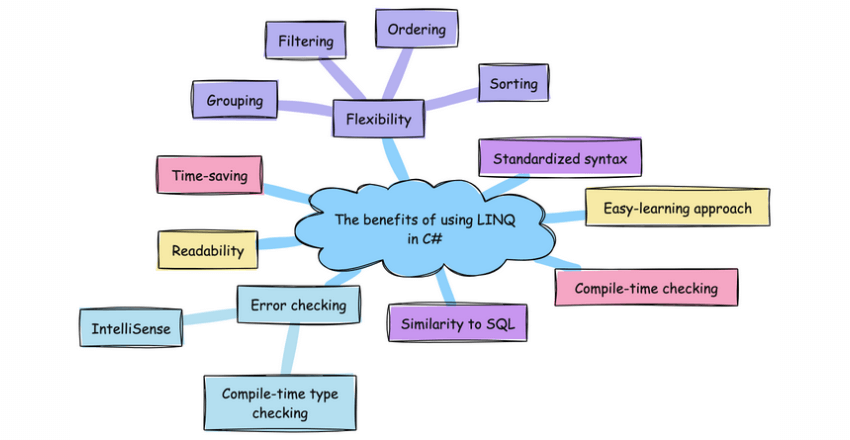
Using Language Integrated Query (LINQ) in C# offers several benefits:
Similarity to SQL: LINQ queries are similar to SQL, making it easier for developers familiar with SQL to understand and use LINQ.
Time-saving: LINQ reduces the amount of code needed to retrieve objects, which can save developers time and increase productivity.
Readability: LINQ queries are more readable than traditional for loops, making it easier for team members to understand and maintain the code.
Error checking: LINQ provides IntelliSense for generic collections and type checking of objects at compile time, which can help catch errors before run-time and simplify debugging.
Flexibility: LINQ supports filtering, sorting, ordering, and grouping operations with less effort compared to traditional methods.
Standardized syntax: LINQ offers a standardized query syntax that can be used across different data sources, such as collections, XML documents, and databases.
Compile-time checking: LINQ queries are compiled, which means type-safety and syntax errors can be caught before run-time, reducing the risk of runtime errors.
Easy-learning approach: LINQ simplifies querying and modifying data, making it easier for developers to learn and use.
LINQ in C# offers a more efficient, readable, and maintainable way to query and manipulate data from various sources. Its similarity to SQL, time-saving capabilities, and error-checking features make it a valuable tool for developers.
How to write a basic linq query
To write a basic LINQ query in C#, you can use both Query Syntax and Method Syntax. Here’s an example of how you can achieve this:
Query Syntax
using System;
using System.Linq;
class Program
{
static void Main(string[] args)
{
int[] numbers = { 1, 2, 3, 4, 5, 6, 7, 8, 9 };
// Query Syntax
var querySyntax = from number in numbers
where number > 3
select number;
foreach (var number in querySyntax)
{
Console.WriteLine(number);
}
}
}In this example, we use the Query Syntax to filter the numbers array and select only the numbers greater than 3. The from clause declares the iteration variable number, and the where clause filters the numbers based on the condition number > 3. Finally, the select clause selects the filtered numbers.
Method Syntax
using System;
using System.Linq;
class Program
{
static void Main(string[] args)
{
int[] numbers = { 1, 2, 3, 4, 5, 6, 7, 8, 9 };
// Method Syntax
var methodSyntax = numbers.Where(number => number > 3);
foreach (var number in methodSyntax)
{
Console.WriteLine(number);
}
}
}In this example, we use the Method Syntax to achieve the same result. We use the Where method on the numbers array and pass a lambda expression as an argument. The lambda expression number => number > 3 defines the condition for filtering the numbers.
Both Query Syntax and Method Syntax are used to filter and select elements from a collection. The choice between the two depends on personal preference and the specific requirements of your code.
So, what is the difference between linq query syntax and method syntax?
LINQ Query Syntax and Method Syntax are two different ways to write LINQ queries in C#. The main difference between the two lies in their syntax and readability.
Query Syntax
Query Syntax is more similar to SQL and is often considered simpler and more readable for developers who are familiar with SQL. It uses keywords like from, where, select, orderby, and join to define the query.
Here’s an example of Query Syntax:
var query1 = from num in numbers where (num % 2) == 0 select num;Method Syntax
Method Syntax, on the other hand, uses method calls like Where, Select, OrderBy, and Join to define the query. It is often considered more readable for developers who are not familiar with SQL.
Here’s an example of Method Syntax:
var query2 = numbers.Where(num => num % 2 == 0).OrderBy(num => num);
Both Query Syntax and Method Syntax can produce the same result, but the choice between the two depends on personal preference and the specific requirements of your code. Query Syntax is often recommended for its simplicity and readability, especially for developers who are familiar with SQL.
However, there is no semantic difference between the two, and the choice between them is a matter of preference.
How to convert a linq query from query syntax to method syntax
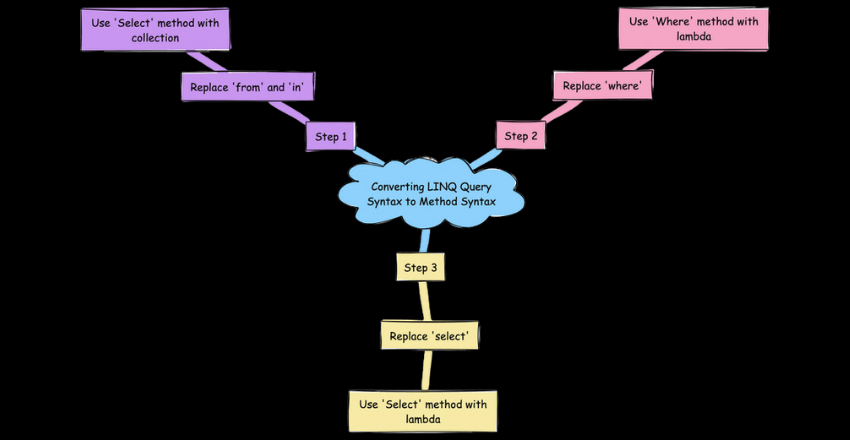
To convert a LINQ query from Query Syntax to Method Syntax, you can follow these steps:
- Replace the from keyword with the Select method and the in keyword with the collection you want to query.
- Replace the where keyword with the Where method and the condition in parentheses with the lambda expression.
- Replace the select keyword with the Select method and the expression after select with the lambda expression.
Here’s an example of how to convert a LINQ query from Query Syntax to Method Syntax:
Query Syntax:
var query1 = from num in numbers
where (num % 2) == 0
select num;Method Syntax:
var query2 = numbers.Where(num => num % 2 == 0).Select(num => num);In this example, we replace the from keyword with Select and in with numbers, the collection we want to query. We replace the where keyword with the Where method and the condition in parentheses with the lambda expression num => num % 2 == 0.
Finally, we replace the select keyword with the Select method and the expression after select with the lambda expression num => num.
Following these steps, you can convert a LINQ query from Query Syntax to Method Syntax.
What are some common mistakes to avoid when using linq query syntax
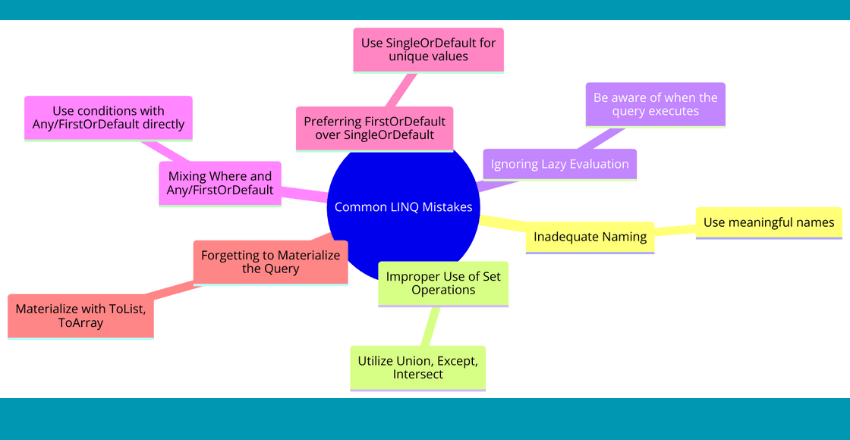
Here are some common mistakes to avoid when using LINQ query syntax:
Inadequate Naming: Using single-letter parameter names in lambda functions can make the code harder to understand, especially in complex queries. It’s important to use meaningful and descriptive parameter names that reflect the purpose of the query.
Improper Use of Set Operations: Developers sometimes don’t take advantage of LINQ’s set operations like Union(), Except(), Intersect(), and SelectMany(), which can lead to less efficient queries.
Ignoring Lazy Evaluation: LINQ employs lazy evaluation, which means the query is not executed until the result is needed. Developers need to be aware of this and ensure the query result is materialized when needed to avoid unintentional re-evaluation of the query.
Mixing Where and Any/FirstOrDefault: It’s better to use the filtering condition directly with Any or FirstOrDefault instead of first using Where and then calling these methods. This can improve performance, especially for large collections.
Preferring FirstOrDefault over SingleOrDefault: When dealing with unique values, it’s better to use SingleOrDefault instead of FirstOrDefault to ensure there is only one matching element in the collection.
Forgetting to Materialize the Query: Developers sometimes forget to materialize the query result using methods like ToList() or ToArray(), which can lead to unexpected behavior when the query is re-evaluated.
By being aware of these common mistakes and following best practices, developers can write more efficient, readable, and maintainable LINQ queries in C#.
What are some common mistakes to avoid when using linq method syntax
Here are some common mistakes to avoid when using LINQ method syntax:
Preferring Count() over Any(): It’s better to use Any() instead of Count() > 0 to check if a collection has any elements that match a condition. Any() is more efficient as it stops evaluating the query as soon as it finds a matching element[2].
Using Where() followed by Any(): Instead of first filtering with Where() and then checking with Any(), it’s better to use the filtering condition directly with Any(). This is more concise and efficient[2].
Using FirstOrDefault() instead of SingleOrDefault() for unique values: When dealing with unique values, it’s better to use SingleOrDefault() instead of FirstOrDefault() to ensure there is only one matching element in the collection
Forgetting about deferred execution: LINQ queries use deferred execution, meaning the query is not executed until the results are enumerated. Developers sometimes forget to materialize the query result using methods like ToList() or ToArray().
Not using method chaining effectively: Method syntax allows for method chaining, which can make the code more concise and readable. Developers should take advantage of this feature when writing LINQ queries.
Overusing method syntax: While method syntax is powerful, it can sometimes be less readable than query syntax, especially for more complex queries. Developers should choose the syntax that best fits the readability and maintainability of their codebase.
By being aware of these common mistakes and following best practices, developers can write more efficient, readable, and maintainable LINQ queries using method syntax in C#.
What are some examples of data sources that can be queried using linq
Some examples of data sources that can be queried using LINQ:
In-Memory Data Structures:
- Arrays
- Lists
- Dictionaries
Any collection that implements the IEnumerable<T> interface
XML Documents:
LINQ to XML allows you to query and manipulate XML data using LINQ syntax
Relational Databases:
LINQ to SQL and LINQ to Entities (Entity Framework) allow you to query relational databases using LINQ
Web Services:
LINQ providers can be implemented to query data from web services by implementing the IQueryable<T> interface
File Systems:
LINQ can be used to query file system data, such as directories and files
Custom Data Sources:
LINQ can be extended to support querying of any data source that implements the IEnumerable<T> or IQueryable<T> interfaces
The key to enabling LINQ querying for a data source is to either implement the IEnumerable<T> interface for in-memory data, or the IQueryable<T> interface for remote data sources. This allows LINQ to translate the queries into the native format of the data source and execute them efficiently.
Wrapping up
LINQ is a versatile and powerful feature of the .NET Framework that simplifies data querying and manipulation. By understanding the basics of LINQ, including its syntax, key concepts, and practical applications, beginners can effectively query and manipulate data across different sources. As you become more familiar with LINQ, you’ll appreciate its ability to make your code more readable, maintainable, and efficient.
External Sources
https://www.linkedin.com/pulse/benefits-using-linq-objects-c-james-turner
https://stackoverflow.com/questions/271384/pros-and-cons-of-linq-language-integrated-query
https://www.partech.nl/en/publications/2021/03/basics-of-linq
https://www.tutlane.com/tutorial/linq/linq-introduction-what-is-linq-why-we-use-linq
https://www.csharpschool.com/blog/8-compelling-reasons-to-use-linq-queries
https://www.c-sharpcorner.com/UploadFile/c5c6e2/using-linq-in-net/
https://www.tutorialsteacher.com/linq/why-linq



